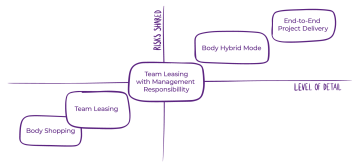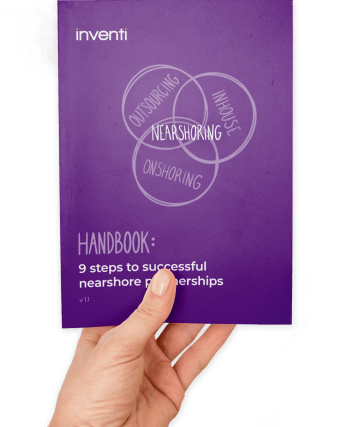Setting up the cooperation with your IT partner might get a bit tricky. There are tons of options and more modifications of them are emerging as we speak. Can’t seem to find out the ideal model for your business? Don’t worry, we’ve got you covered.
In the article Cooperating with your IT partner: The best models and their benefits, we summarized the most common IT cooperation models and neatly sorted them based on various factors.
Now, let’s move on and choose the right IT cooperation model for you.
If your IT department is developed in all necessary areas and you need to scale it quickly in time, you will probably decide between Body Shopping and one of the versions of Team Leasing.
But how to decide when this is not the case?
| Body Shopping |
Accessible assistance in the absence of technical know-how or capacity. The capacity for detailed tasking is needed. |
|---|---|
| Team Leasing |
Suitable for quick scaling of projects/teams. The capacity for detailed tasking is needed. |
| Team Leasing with Management Responsibility |
Suitable for quick scaling of projects/teams. The capacity for detailed tasking is not needed. |
| Hybrid mode |
Suitable when there’s no need to monitor the project in detail. Flexibility in changing the business assignment. An optimal Benefit-Cost Ratio. |
| End-to-End Project Delivery |
Suitable when there’s a clear idea about the final solution. No need to change it drastically during the project. All the realization risks are beared by the supplier. |
There are two basic aspects that determine the selection
The ability of your organization to define what you want.
If you are able to describe clearly and in detail what the solution should do, what it should look like and who should use it as well as what it’s going to be integrated into and how, you should decide among Team Leasing, Hybrid mode and End-to-End Project Delivery.
You can prepare the project plan yourself or with the help of consultants that are able to help you or create it all by themselves. They can also help you select the ideal IT partner.
The ability of your organization to share the risk with the supplier.
If you don’t want to bear the risk yourself, you should select End-to-End Project Delivery. In this case, all of the risks related to the project creation are transferred to the supplier. Keep in mind that this fact is included in the price of the work (the supplier includes potential risks in their calculation). Another potential disadvantage is lower flexibility in changing the project subject.

“In recent years, we see a noticeable shift from End-to-End Project Delivery to Team Leasing and various types of Hybrid mode. We know from experience that it’s mainly related to the growing emphasis on the shortest possible time between the idea and the moment the solution is used by end users.”
– Radim Dodek –
Consultant at INVENTI
At INVENTI, we analyze the needs of the client in order to offer an appropriate solution meeting the objectives. At the same time, we consider the suitable cooperation forms.
When making proposals, we consider the readiness of the project’s input documentation as well as the client’s experience with managing similar projects. We talk about the willingness to bear risks related to the project with them.
Last but not least, we have to know the cooperation method the client is counting on. The supplier is never able to deliver a project without cooperating with the client. The cooperation model defines the scope of it.
„Often, clients who don’t have that much experience in the area of IT solution development calculate the project costs purely from the numbers they receive from the supplier. They forget to include the costs connected with implementation on their side. These should be considered when calculating the ROI as well. It is more and more common that the client’s management department appoints a subordinate as SPOC (single point of contact) for the supplier but doesn’t reserve part of their capacity for this activity.“
During the business phase, we offer more options that we explain in context to the client. Therefore, they are able to decide what’s best for them.
Handbook:
9 steps to successful
nearshoring partnerships
In 9 simple steps find out how to maintain the right nearshoring partner that can fully support your digital innovation and smart resourcing.

Handbook:
9 steps to successful
nearshoring partnerships

